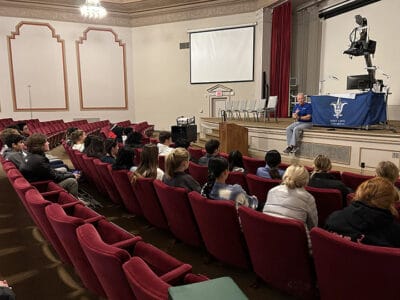Students in Upper School Teachers Stacey Morgan and Ben Krueger’s Anatomy and Physiology class had the opportunity to experience what it’s like to be medical school students this week when they visited the cadaver lab at St. Louis University Medical School.
Studying cadavers is not for the faint of heart. However, this was an exciting opportunity to expand their learning of human anatomy. The field trip starts in the auditorium, where the students learn about the donation process, lab procedures, and more.

From there, they go downstairs to the lab, where they are put into small groups for a cadaver presentation. Medical students lead these groups, showing the systems of the body and major organs while also discussing function, pathology, organ donation, and more. The visit enables MICDS students to observe and touch the structures they have learned about, ask questions, and participate in sharing what they have learned in the process.
„It was incredibly interesting getting to see the body systems in person,“ said Alana Doherty ’24. „We learn about each system individually and how they work together, but getting to actually see how they are connected gave me a new perspective. My favorite part was getting to see a knee replacement and a pacemaker. Seeing how they are connected to the body and how they work to replace impaired biological functions was so cool. I had heard about how all of these systems worked and what they did for the body, but having a hands-on experience where I could touch lung tissue and compare it to the thyroid while talking through all of these systems with an actual med student just tied everything together. The student also made what she was saying easy to understand, and she made it very clear as to what we were looking at while still giving us time to participate. This was the next level from your everyday high school lab and provided real-life context to what I was learning.“
The anatomy and physiology program at MICDS is designed to be a case-study-based adventure that examines the structures and functions of the human body and mechanisms for maintaining homeostasis within the body. Morgan and Krueger create experiences that provide hands-on learning and critical thinking and make connections between the curricular content and real-world applications. They enjoy seeing their students connect what they learned in class to the actual human body. Many of their students are interested in studying medicine, so this is a wonderful opportunity for them to ask current medical students any questions they might have. Most people will never experience a cadaver lab, and even interested students don’t see one until they’re already in a college medical program, so this was a wonderful opportunity for a sneak peek into the profession.
„Our kids love it and really lean into the experience,“ said Morgan.
